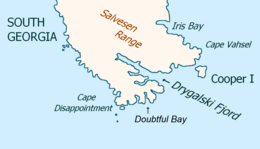Cooper_Island
Cooper Island
Small island near South Georgia
Cooper Island is a small island, 2 miles (3.2 km) long, which lies at the north side of the entrance to Drygalski Fjord, off the southeast end of South Georgia. It was discovered by a British expedition under James Cook in 1775, and named for Lieutenant Robert Palliser Cooper, an officer aboard HMS Resolution.
This article needs additional citations for verification. (November 2011) |
A navigable channel, Cooper Sound, nearly 1 mile (1.6 km) wide, separates Cooper Island from the coast of the main island of South Georgia. There is a small bay, Known as Cooper Bay, 1.3 miles (2.1 km) southwest of Cape Vahsel on the mainland, and 1 mile (1.6 km) northwest of Cooper Island, indenting the southeast end of South Georgia, which derives its name from Cooper Island.
The island reaches 416 metres (1,365 ft) at its highest point, and the upper parts of the island are above the snow line.


